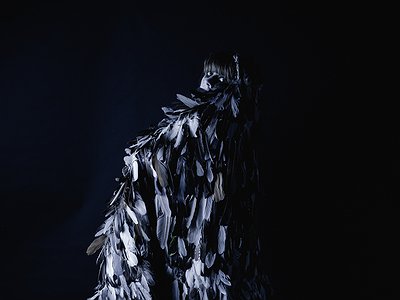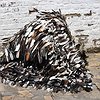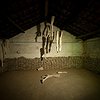Name: Rebecca Lenaerts
Nationality: Belgian
Occupation: Performance art (inspired by Japanese Butoh)
Current Project: Still a bird, a performance on the crossroad between dance, theatre and visual art.
Recommendations: Eiko & Koma performances /Conference of the Birds by Attar of Nishapur
If you enjoyed this interview with Rebecca Lenaerts, visit her website rebeccalenaerts.net/artistiek-werk to learn more.
Where does the impulse to create something come from for you?
Being spiritual means to be connected with all that exists, not only the visible but also the invisible world. If you live a connected life, creativity will naturally find an outcome. Be it in the form of art or gardening, cooking, bread making, flower arranging, building something, writing, singing, ... What’s important is the intention you create and the love you put into it. Creation is bringing to the surface what already exists. That is a spiritual act.
For me the purpose of artistic creation is, in its essence, to create beauty and harmony. The creative state is like a way of being. An attitude. It is not a button you push in or switch off. Rather it is a constant flow, a stream. A lot of my daily activities are related to keeping this flow vivid and clean. Taking time to wash my clothes is as important as talking to friends, journaling, drawing, reading, teaching, going to a museum or do nothing. It all comes down to keeping balance.
What role do often-quoted sources of inspiration like dreams, other forms of art, personal relationships, politics etc play?
Since I encountered Japanese Butoh dance, my attention is much more directed towards nature and the body. Butoh is a movement practice in which the performer connects with the deeply embedded knowledge of the body, shaped by environmental information, imagination, history and trauma. The body contains a story that resonates through movement. An audience often witnesses a blooming or dying off. Nature is an excellent teacher in showing how to embody transformation. I find it important to have examples. The best inspiration comes from the experience called 'life' itself.
Since sharing my knowledge and experience with Butoh in weekly classes, I find myself in a situation where I become an example for others. I invest a lot of time in collecting materials to illustrate what I teach and to nurture the inspiration of others. Mostly I use pictures of paintings and sculptures. Also photographs or video fragments. Music plays an important role to create an atmosphere to lean into.
For you to get started, do there need to be concrete ideas – or what some have called a 'visualisation' of the finished work?
The performance Still a bird arose from the wish to dance and to share this dance with an audience. When I collected bird feathers, I suddenly had this vision of a feather cloak. But that was only an image in my head until I finally took action and asked a friend to help me. I had never worked with a sewing machine before. Over a period of nine months I sewed the feathers one by one on a blanket. During these months of work, the vision of a bird woman came up. She was the inspiration for the later dance. I asked myself: How does this feather cloak make me move? By searching pictures of bird women, I found drawings of females covered with feathers like a shield, a harness. This brought me to the subject of female warriors and the interaction between beauty and (inner) strength. The latter now seems to be slowly evolving into a new project.
Often, while writing, new ideas and alternative roads will open themselves up, pulling and pushing the creator in a different direction. Does this happen to you, too, and how do you deal with it? What do you do with these ideas?
A lot of my ideas are related to learning a new skill or getting immersed in a new subject. I often collaborate with artists working in other artistic disciplines than myself. So, the element of time and (ex)change is inherently connected to my work. I like co-creative work processes. It is like meeting someone from a different cultural background. Dialogue is key. Ideas or visions can stick for years with me until they finally find an outcome, often in a different form than originally thought. I allow ideas to grow and to transform. There is nothing that is not touching something else. I learned to be patient and to trust that the right time will come. If not, then the idea was maybe not a good one. Pulling, pushing and to make things work at any cost is very exhausting. Sometimes the desire or the intention behind an idea is more important than the actual idea. It helps to take time. To go slow.
What does the balance between planning and chance look like for you?
In order to navigate myself properly I learned order and structure. I also learned to switch between activities and to stop on time. There is so much information, so many possibilities and so much trash out there that I find it necessary to make a conscious choice about what I take in and what to neglect and reject. The result is less noise and dust, more empty space and freedom.
Is there a preparation phase for your process? Do you require your tools to be laid out in a particular way, for example, do you need to do 'research' or create 'early versions'?
For a few months I’ve had access to my own studio. Suddenly a range of possibilities present themselves. I used to work from home a lot. Spending a lot of hours behind a computer screen writing applications for funding or residencies. It helped me to make my ideas concrete. I prepare on paper what I am going to do in the future. But I got really tired of this way of working. I could feel the desire for a place where I can just be, move, mess up, build things, leave it and come back the next day without accountability or explanation why I am doing what I am doing. If I like to try out something I don't have to find a place first and explain or convince some one. I also felt the necessity for a more natural flow between making and showing, process and result. Showing a first result can be part of the process. Sharing a research can be the result. I strive for a more circular way of working with a better balance between the effort it takes to finish a creation and then put that work out into the world.




